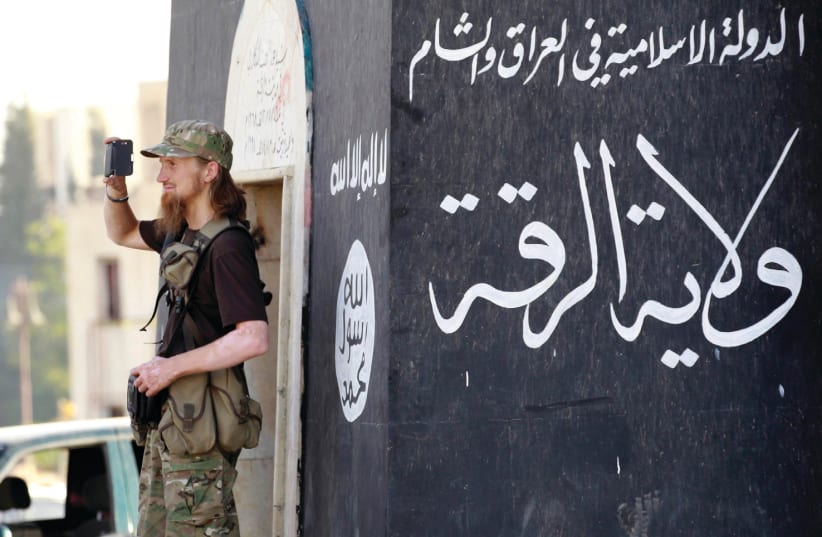Seven years ago members of ISIS kidnapped more than 1,700 unarmed young cadets who had been training in Iraq and executed them.The Speicher Massacre as it became known was one of the first examples of the genocidal brutality of ISIS. Nothing on this scale had been done before, with such Nazi-like systematic murder, by a terrorist group and it illustrated how ISIS was not like Al Qaeda or groups that came before.Terror groups had done major bombings before, targeting Shi’ites, Christians and Yazidis in Iraq, but this was a more complex plan and the men who were massacred were carefully chosen and moved around before their execution.
So many men were murdered in one place that the streams flowed red with blood. In other cases they were taken to the dry desert and machine gunned. ISIS would do the same later when they targeted Yazidis, but they would increase their brutality by selling women and children into slavery. Thousands of Yazidi women and children are still missing.
Memorials for the victims of Speicher have grown over the years, as well as the capture and punishment of some perpetrators. Today in Iraq some are tweeting with a hashtag in memory.According to reports the remains of hundreds are still missing or unaccounted for. The massacre of the cadets roused Iraq to resistance against ISIS. The international community did nothing to help Iraq stop the massacre or stop ISIS at the time. Instead social media tech giants openly permitted ISIS to post the videos of the killings of the mostly Shi’ite cadets.
In those days ISIS was openly recruiting online using Facebook and Twitter. Throughout Europe people were posting messages about “killing the kuffar” and praising ISIS. Eventually more than 5,000 people from various European states would join ISIS, many of them collaborating in the worst crimes in Iraq and Syria. Chechans from Russia also came, as did thousands from Turkey, crossing the border that Turkey left open so some 50,000 could join ISIS in 2014 and 2015.
While the world did nothing, Iran sent advisors to Iraq to help fight ISIS, a group supported by Sunni insurgents in Iraq, which had gained support in Iraqi towns and cities like Mosul, Ramadi, Tikfrit, Fallujah and other areas. ISIS rapidly captured these mostly Sunni cities, expelling and massacring minorities. At Badush prison in Mosul in June 2014 some 670 Shi’ite prisoners were murdered by ISIS. Some of their remains were found last month, bringing the mass graves ISIS left behind to total some 6,393 bodies so far.
The massacre at Speicher and the retreating Iraqi army, whole divisions melting away and leaving behind thousands of vehicles and arms to be captured by ISIS, led Grand Ayatollah Ali Sistani to issue a call to arms in the wake of the June 12 disasters. Young men would be called to arms, every one of them told to come and defend the “people, the honor and the sacred places.” In the US President Barack Obama told reporters. That the US would not be sending troops back, but he noted Iraq needed support to stop the “momentum of extremist groups.”
Some human rights groups, ignoring ISIS crimes at the time, condemned the Iraqi government of Nouri al-Maliki, ignoring the mass murder at Speicher, and continuing to ignore the expulsion of Shi’ites, Yazidis and Christians in areas ISIS controlled. In the most infamous tweet Human Rights Watch head Ken Roth tweeted on June 11, 2014 “ISIS in Iraq reportedly tried not to alienate local population, unlike PM Maliki and his violent sectarian repression.”
While the international community ignored, supported or did nothing to stop ISIS, it was the young Shi’ite men called to arms by Sistani who were left along to fight the Nazi-like extremism sweeping Iraq. They came by the thousands in June 2014 and within a year ISIS had been checked, by 2016 the legions called up by Sistani were at the gates of Mosul.
By that time the international community had realized the threat of ISIS, Obama and his team had intervened after the genocide in Sinjar in August 2014. Seventy countries signed on to help stop the extremists and social media giants removed hundreds of thousands of pro-ISIS accounts.
By 2019 ISIS was mostly defeated. But the horrors that began on June 12 continue to haunt Iraq and Syria. The militias called up by Sistani have grown more powerful and Iran’s role in Iraq has grown. Those who today complain about Iran’s role in Iraq and the militias often did little to stop ISIS in June 2014. Some of them even quietly supported or sympathized with ISIS, feeding a myth among some western analysts that empowering Sunni Islamist extremists will somehow balance Iran. It didn’t balance Iran, it empowered Iran.
ISIS carved out a swatch of destruction from Speicher to Sinjar and Raqqa, even stretching to Aleppo and Idlib with networks. It preyed on the weakness of states that had come in the wake of the Arab spring and the defeat of ISIS has brought back powerful states and led Turkey and Iran to intervene more rapidly in the region.
